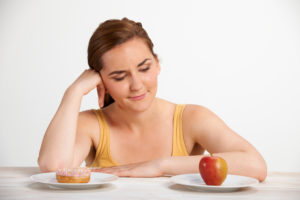Nutrition – The Key To Eating To Lose Weight

When you read most publications on losing weight, you’ll quickly see that diet is the overwhelming indicator of losing weight or not.
It comes down to burning more calories each day than you eat. This is known as a calorie deficit or negative energy balance. When you do that, the body digs into its fat stores to make up the difference between the calories you consume and the ones you burn.
The Science Of Weight Loss
Losing weight is 80% about the food you eat and 20% about exercising. The 80% can be further broken down into the types and quantity of food.
If you eat more calories than you burn, you’ll gain weight which is why you’re overweight in the first place. And while we could get deep into the weeds about all the other nuances that affect weight gain, it basically comes down to overeating.
This is where the weight loss comes from – making up that difference. You want to have around a 500-calorie-per-day deficit. In a week that should translate into about a pound of weight lost.
Free Report: 15 Foods To Eat Before & After Your Workouts
What Are You Eating To Lose Weight?
Eating to lose weight needs to focus on low carb, but also high fiber and protein. The low carb part, of course, controls the number of calories consumed, but why the fiber?
Fiber does two things. One is it creates bulk in your system, thus keeping you feeling fuller longer. So, if you eat based on when you feel hungry, eating a high fiber diet should keep you satisfied longer meaning you will be less likely to raid the pantry looking for a snack (most of which will be likely unhealthy at best).
Second, fiber slows down the digestion rate of food, thus creating a more even flow of nutrients into your blood stream. As a result, the food you eat lasts longer and prevents glucose spikes and the resulting “sugar” crashes that leave you hungry and rushing to the fridge to get something to eat.
As far as the foods you should be eating, focus on non-starchy vegetables – especially the dark green, leafy kind, along with berries, avocados, whole grains, nuts and seeds, and high fiber cereals that have either low or no sugar.
Know Your Numbers
Assuming a 1,600 calorie per day diet gives you a 500-calorie-per-day deficit, those calories should come from:
- 40% from complex carbohydrates
- 30% from fats
- 30% from protein.
At 4 calories per grams, this gives you about 160 grams of carbs, 53 grams of fat and 120 grams of protein – all of which are in line with the Recommended Dietary Allowances (RDA) for Americans. Based on your BMR – the number of calories you burn at rest – and your activity level, you may need more calories to sustain you, but this at least gives you a starting point.
Knowing these numbers, now you can read a nutrition label and not only see how constitutes one serving, but also the number of grams of carbs, fat and protein in that serving. That makes keeping track of the number of calories of each one per day much easier.
Exercise and Eating To Lose Weight
It is possible to lose weight just from eating properly, however, you’ll want to exercise too. Some foods play an important role not only as a source of energy for your body, but also for your health and should be factored in as part of your daily requirement. Your body needs a certain kind of nutrition in each stage of an exercise workout. This free report, 15 Foods To Eat Before & After Your Workout reveals why certain types of weight loss foods are best at both ends of an exercise session.


Pingback: What Are The Best Foods For A Healthy Lifestyle?